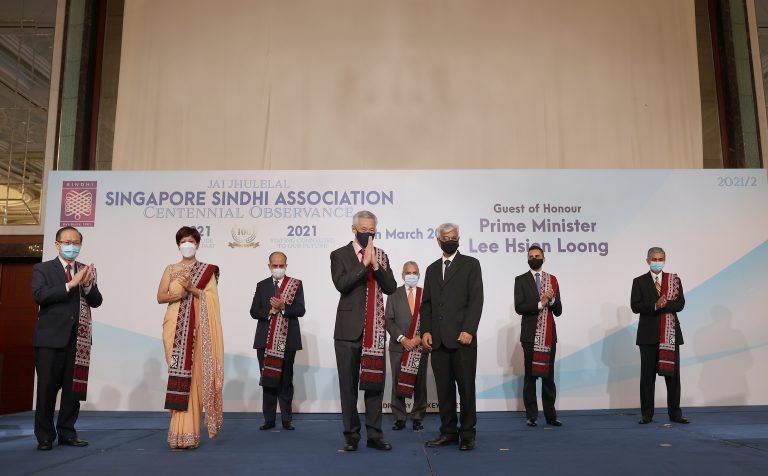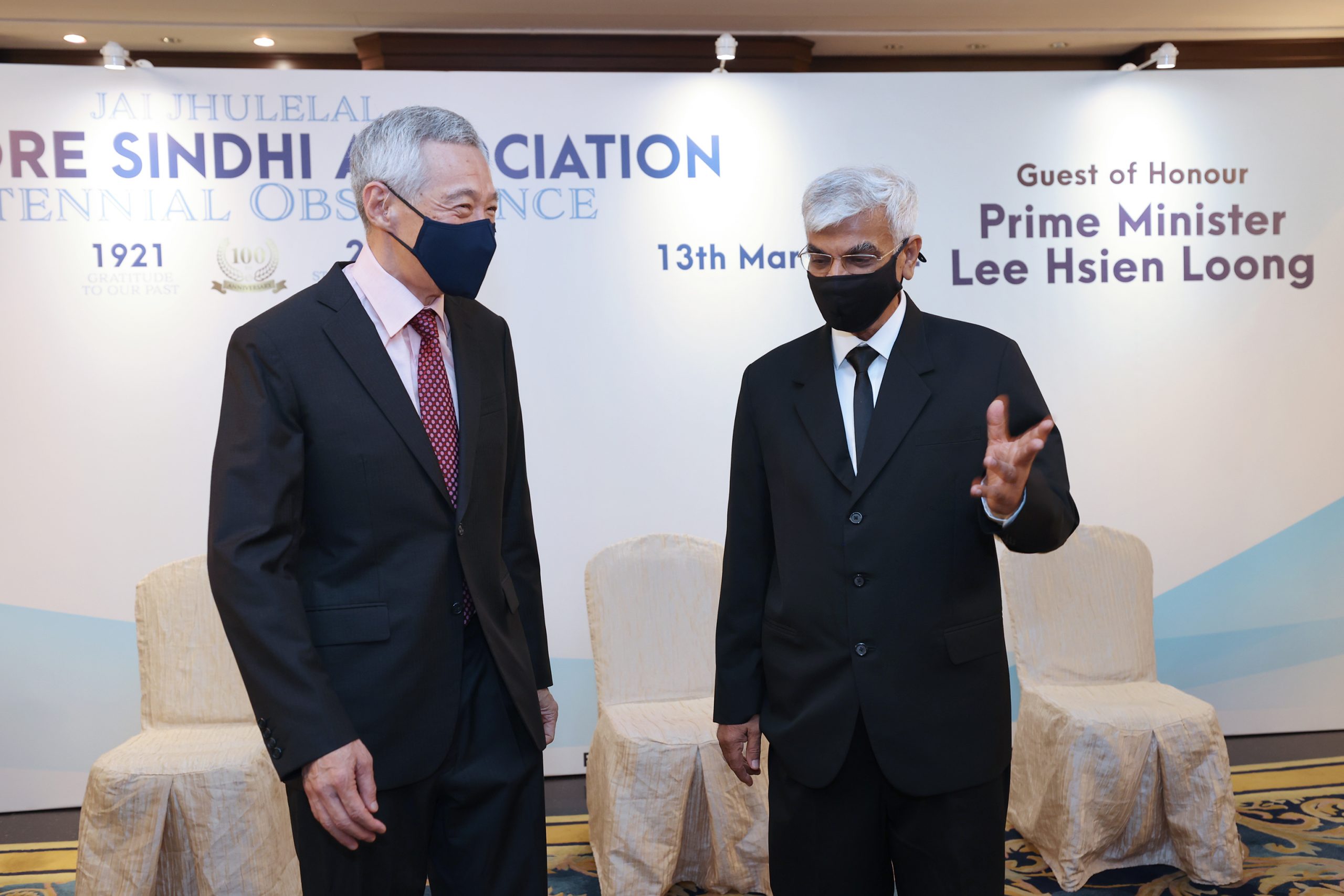
Transcript of Speech by Prime Minister Lee Hsien Loong at Singapore Sindhi Association (SSA) Centennial Observance on 13 March 2022 at Shangri-La Singapore.
 Mr. Vashdev Khialani, President of the Singapore Sindhi Association
Mr. Vashdev Khialani, President of the Singapore Sindhi Association
HE Mr. Kumaran, High Commissioner of India
Distinguished guests
Ladies and gentlemen
A very good evening to everybody
I am delighted to be here this evening to celebrate the Singapore Sindhi Association’s (SSA) centenary. The SSA is one of the oldest registered Indian associations in Singapore, and reaching 100 years is truly a major achievement to be proud of. It reflects the dedication and endurance of your pioneers, your members and your volunteers, and is also a timely celebration with just a few weeks before the start of the Sindhi New Year, which this year will be on 2 April.
SSA
Mr. Vashdev spoke earlier on the history of the SSA and its many contributions. Beginning with its founding in 1921 as the Sindhi Merchants Association, providing support to Sindhi businessmen coming to Singapore, and how the Association has continuously grown, and expanded its roles, including organizing social and religious activities for the community, and how it was named the Singapore Sindhi Association in 2003, to better reflect its mission to serve the needs of the entire Sindhi community in Singapore.
Through the years, the SSA has proven itself to be a pillar of support for the Sindhi community.
Sindhi Community
The Sindhis in Singapore, form part of the larger Sindhi diaspora, that have settled in different parts of the world.
You originate, as the video showed, from the land of Sindh in present-day Pakistan. Sindh has been a key trading hub in South Asia for thousands of years. It is located along critical land trade routes linking India to the Middle East, to Central Asia, and to Europe, and also along sea trade routes between the East and the West. Given this strategic location, it is not surprising that many Sindhis became merchants and traders. From one generation to the next, they have built far-flung networks and honed their business acumen. They have also developed other traits – diligence, perseverance in the face of adversity, willingness to take calculated risks. These are critical ingredients behind the success of the Sindhi diaspora today.
It is a tightly knit diaspora, with a strong sense of identity. The Sindhis take great pride in their heritage and culture with its distinct elements such as the Ajrak, the Sindhi topi, the cap, and the Dal Pakwan, a breakfast food. No meal tonight because of safe management measures, but at the next event, hopefully meals would be possible.
Recently, the Sindhis worldwide have designated the first Sunday of December as the Sindhi Culture Day – a day for all Sindhi communities across the world to come together, and celebrate their rich traditions and customs. Whenever a Sindhi does business in unfamiliar territory, he can always find a fellow Sindhi to turn to for support, to open doors to new opportunities. These connections come in handy in other ways as well – for example, I am told on reliable authority that Sindhis often tap on their global networks to source for suitable marriage partners for their children!
Wherever they go, the Sindhi communities also strive to integrate themselves as part of their host society, to contribute to its development and to build ties with the other local community groups, and that is exactly what the Singapore Sindhis have done. While the community itself is quite small, 7,000 people, the Sindhis have played a significant part in Singapore’s development. Many who came to Singapore in the late 19th and early 20th centuries were merchants. Some of you may remember their shops along High Street selling textiles and trading, which was in those days the center of our town, the Orchard Road equivalent.
These traders took full advantage of Singapore’s role as an entrepot. They built a niche trade in textiles, importing from Japan, Korea and China, and re-exporting to other regions like Southeast Asia, Middle East, and America. Later they ventured into new areas like electronics trade. Nowadays, many Sindhis have gone beyond their merchant and trading roots. Whether they are in government, or in professions like medicine, law, or engineering, they have contributed to their respective fields and made their mark. Over the years, the Sindhi community has established deep and enduring roots here, growing with our nation from third world to first.
Indeed, the Sindhis have been exemplary citizens. Embracing the Singaporean multi-racial, multi-religious identity, learning about other communities and groups, while sharing their own heritage and culture, and building shared experiences through living, working, and playing alongside fellow Singaporeans from many other groups. The SSA has played a valuable role, fostering integration between Sindhi and the other groups. Jointly celebrating each other’s cultural festivals, generously doing its part for the broader society, for example: volunteering at and donating to nursing homes, orphanages, and religious places of worship; organizing blood donation drives; setting up pro bono legal clinics open to all needy Singaporeans. Your efforts have enlarged our common spaces, built bridges, and brought Singaporeans closer together.
Conclusion
Singapore’s multi-racial society is founded on our many and diverse ethnic groups. Within the major ethnic groups – the Chinese, Malays, Indians, and Eurasians, there are many subgroups, of whom the Sindhis are one. But we also have other smaller minority groups – like the Jews, the Parsis, the Armenians, and others. With time over generations, these groups have all sunk roots here and become Singaporeans, while maintaining their distinct identities and cultures, and therefore, each group adds to our rich social tapestry, and extends our connections with their communities living in many other parts of the world.
While many of these groups have come here during our colonial past, our diversity is not static. We have continued to welcome new arrivals to Singapore, while keeping our broad ethnic balance stable. Some marry Singaporeans and start families here, others initially come here to work, bring their families, and eventually decide to become Singaporeans. We encourage these new arrivals to preserve their distinct cultures and traditions, which contribute to the vibrancy of our society. But at the same time, we also urge them to make the effort to integrate into our society, to appreciate, respect, and celebrate the precious multi-racial and multi-religious harmony that we have here in Singapore, just as the Sindhis themselves have done for more than a hundred years so successfully. By fostering a shared Singapore identity and a sense of belonging, we will remain a cohesive and united people.
I would like to thank the Sindhi community and the SSA for your unremitting efforts and contributions to Singapore’s growth and prosperity, and for enriching and strengthening our social fabric.
Congratulations on reaching your 100th birthday. We all look forward to many more contributions from the SSA and the Sindhi community in the years to come.
I wish all Sindhis a happy Cheti Chand in advance.
Thank you very much.
_____________________
Courtesy: Prime Minister’s Office